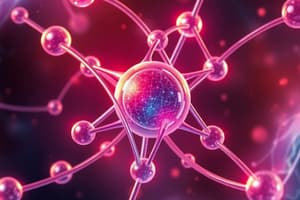Podcast
Questions and Answers
What is the atomic mass number of an element?
What is the atomic mass number of an element?
- The number of protons in the atom's nucleus
- The number of neutrons in the atom's nucleus
- The sum of the number of protons and neutrons in the atom's nucleus (correct)
- The difference between the number of protons and neutrons in the atom's nucleus
Which of these is NOT a characteristic of organic molecules?
Which of these is NOT a characteristic of organic molecules?
- They can be very complex in structure
- They are essential for life as we know it
- They always contain oxygen atoms (correct)
- They contain at least one carbon atom
What is the relationship between the number of electron shells and the period of an element on the periodic table?
What is the relationship between the number of electron shells and the period of an element on the periodic table?
- The period number is equal to the number of neutrons in an atom of that element
- The period number indicates the number of electron shells in an atom of that element (correct)
- The period number is equal to the number of protons in an atom of that element
- The period number is determined by the atom's electronegativity
What is the main factor that determines an element's electronegativity?
What is the main factor that determines an element's electronegativity?
Which of the following statements accurately describes isotopes?
Which of the following statements accurately describes isotopes?
How many neutrons are present in an isotope of nitrogen with an atomic mass number of 15, knowing that nitrogen has an atomic number of 7?
How many neutrons are present in an isotope of nitrogen with an atomic mass number of 15, knowing that nitrogen has an atomic number of 7?
Which of the following statements correctly describes the relationship between electronegativity and the periodic table?
Which of the following statements correctly describes the relationship between electronegativity and the periodic table?
What is the primary difference between a chemical compound and a molecule?
What is the primary difference between a chemical compound and a molecule?
Flashcards
Matter
Matter
Anything that has mass and takes up space.
Element
Element
A pure substance that cannot be broken down into other substances and has distinct properties.
Atom
Atom
The smallest unit of an element that retains its properties.
Protons
Protons
Signup and view all the flashcards
Atomic Number
Atomic Number
Signup and view all the flashcards
Isotopes
Isotopes
Signup and view all the flashcards
Electronegativity
Electronegativity
Signup and view all the flashcards
Chemical Compounds
Chemical Compounds
Signup and view all the flashcards
Study Notes
Origins of Life
- Matter is anything with mass and takes up space
- Elements are pure substances with unique physical and chemical properties
- Atoms are the smallest unit of an element that retains its properties
Parts of an Atom
- Nucleus: Dense center containing protons and neutrons
- Protons are positively charged particles
- Neutrons are neutral particles
- Electrons are negatively charged particles orbiting the nucleus in shells
Atomic Structure
- Atomic number is the number of protons in an atom's nucleus
- Isotopes have the same number of protons but different numbers of neutrons
- Atomic mass is the sum of protons and neutrons in an isotope
Periodic Table
- Columns (groups) contain elements with similar properties
- Rows (periods) indicate the number of electron shells
- Electronegativity increases when moving up and to the right on the table
- Elements can donate or accept electrons to form chemical bonds
Chemical Bonds
- Atoms form bonds to become more stable
- Covalent bonds involve sharing electrons
- Nonpolar covalent bonds share electrons equally
- Polar covalent bonds share electrons unequally
- Ionic bonds involve the transfer of electrons
- Hydrogen bonds are weak attractions between a hydrogen atom in one molecule and an electronegative atom in another molecule
Molecules and Compounds
- Molecules are groups of atoms held together by chemical bonds
- Compounds are molecules composed of two or more elements in a fixed ratio
Studying That Suits You
Use AI to generate personalized quizzes and flashcards to suit your learning preferences.




